英文科技论文写作与投稿
- 格式:docx
- 大小:17.38 KB
- 文档页数:3
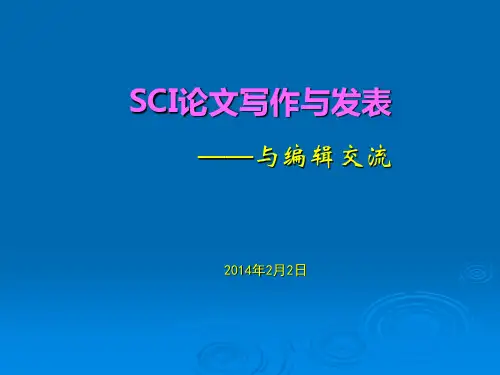
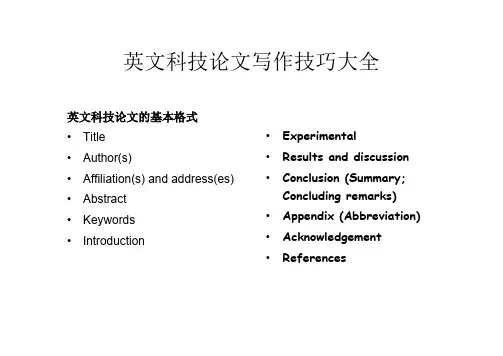
英文科技论文写作技巧大全英文科技论文的基本格式•Title•Author(s)•Affiliation(s) and address(es) •Abstract•Keywords•Introduction •Experimental •Results and discussion •Conclusion (Summary;Concluding remarks) •Appendix (Abbreviation)•Acknowledgement •References2.基本要求(1)Title长短适中,概括性强,重点突出,一目了然。
(2)Author(s)姓氏和名字要容易弄清楚,以免发生以名代姓。
(3)Affiliation(s) and address(es)准确清楚,使读者能按所列信息顺利地与作者联系。
(4)Abstract不宜太详尽,也不宜太简短,应将论文的研究体系、主要方法、重要发现、主要结论等,简明扼要地加以概括。
不要将结论与提要重复使用。
(5)Introduction说明本研究的目的意义。
归纳与本研究密切相关的前人研究结果及有关文献,指出本研究与前人研究的不同之处。
说明本论文要解决的问题及方法、手段等。
不宜将本论文的结果在“绪论”中叙述。
(6)Experimental叙述主要的实验过程、方法、仪器设备、试剂来源及规格等。
不宜将实验结果在“实验部分”中叙述。
(7)Results and discussion是论文的核心部分,要求:–数据及图表的内容及含义交代清楚,有条理;–对数据及现象的归纳、演绎、解释、立论要有逻辑性、自洽性。
–语句要准确、流畅、多样化,不宜重复使用相同的句型和词汇。
(8)Conclusion (Summary, Concluding remarks)简明扼要地归纳出本论文的新发现、新观点、新理论等。
不宜将“结果及讨论”部分的语句直接抄录作为结论。
(9)References要按所投杂志规定的格式准确书写。
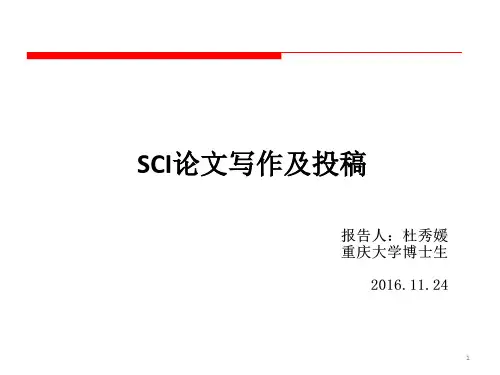
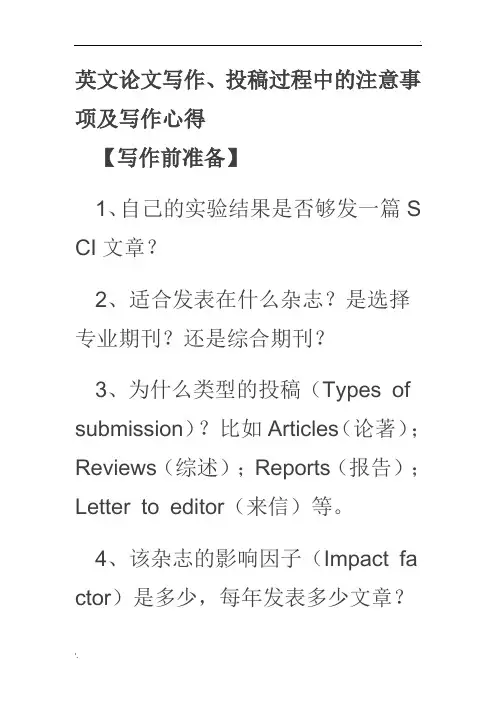
英文论文写作、投稿过程中的注意事项及写作心得【写作前准备】1、自己的实验结果是否够发一篇S CI文章?2、适合发表在什么杂志?是选择专业期刊?还是综合期刊?3、为什么类型的投稿(Types of submission)?比如Articles(论著);Reviews(综述);Reports(报告);Letter to editor(来信)等。
4、该杂志的影响因子(Impact fa ctor)是多少,每年发表多少文章?是否有过本土中国人在上面发表?(便于评价自己的文章被接收的可能性)。
6、有没有下载该杂志最新的投稿须知(Instructions for authors)?7、是否弄清楚了投稿须知各个条目的意思?8、是否接收网上投稿(Submission on line)(一般有网上投稿的杂志更为方便)?9、是否收版面费(Page charge s)?如果论文被接收,自己的经济能力能否支付该杂志的发表全部费用。
10、手头有多少相关内容的文献?(越多越好,这样写作的时候能借鉴他们的思路和语句,对分析讨论的开展也很有好处)【写作环节】1、不要用中国式的思维去写英文句子。
2、套用老外的写作思路(比如前言第1段写对疾病的认识及重要性,第2段对基本背景知识的介绍,第3段如何引出研究问题。
讨论部分往往每一段第一句为该段的中心句。
)3、格式一定要严格按照所投杂志的要求来排版(可以参考投稿须知的要求和该杂志最近发表的文章,要做到一模一样,这样编辑认为你是认真对待的)。
4、避免使用首次发现,该研究特别有意义的语句(老外喜欢你陈述事实,是不是首次发现由别人说了算,有没有意义需要时间来检验)。
5、首页有什么特殊要求?比如是否写清了通讯作者(Corresponding author)和页眉标题(Running title),Running title是否符合字符数要求,一般50个字符以下。
首页是否要求标明全文字符数(The number of c haracters must be listed on the ti tle page)。

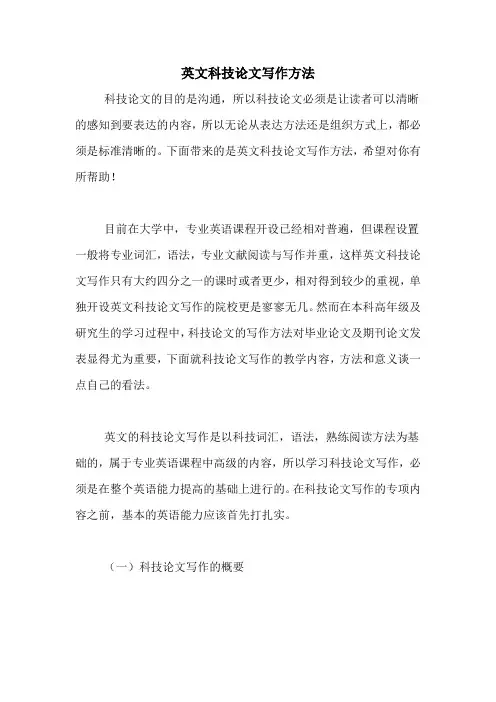
英文科技论文写作方法科技论文的目的是沟通,所以科技论文必须是让读者可以清晰的感知到要表达的内容,所以无论从表达方法还是组织方式上,都必须是标准清晰的。
下面带来的是英文科技论文写作方法,希望对你有所帮助!目前在大学中,专业英语课程开设已经相对普遍,但课程设置一般将专业词汇,语法,专业文献阅读与写作并重,这样英文科技论文写作只有大约四分之一的课时或者更少,相对得到较少的重视,单独开设英文科技论文写作的院校更是寥寥无几。
然而在本科高年级及研究生的学习过程中,科技论文的写作方法对毕业论文及期刊论文发表显得尤为重要,下面就科技论文写作的教学内容,方法和意义谈一点自己的看法。
英文的科技论文写作是以科技词汇,语法,熟练阅读方法为基础的,属于专业英语课程中高级的内容,所以学习科技论文写作,必须是在整个英语能力提高的基础上进行的。
在科技论文写作的专项内容之前,基本的英语能力应该首先打扎实。
(一)科技论文写作的概要科技论文写作是科研工作者的必修课,科学研究工作中,沟通主要是靠科技论文,所以科研人员学术水平的衡量标准在很大程度上是他论文的发表情况。
科技论文不能不得到重视,科技论文不像其它文章的写作,不需要过多修饰,只需要严谨和清晰,要简洁无累述。
从古时起,人类便通过各种文字符号作为沟通的主要手段,这便成为科学与文明的主要传载者,也是科技论文发展的前身。
当今,科技论文写作即是以规范的形式,通过规范的审核及流程,正规发表在期刊上的过程。
所谓正规发表即是,有可以被评估的原始资料,可以被重复的实验过程,可以被评估的推导过程。
(二)科技论文各项内容的写作要点科技论文写作应该分为:标题,摘要,引言,正文,结论,讨论和 __几大部分。
科技论文的标题位于第一行正中,不用加标点,常用动名词的短语代替完整的句子。
如有要加副标题,用冒号隔开。
作者的姓名和地址写在标题的正下方,中 __姓名和地名均按照汉语排序用汉语拼写书写即可。
摘要是全文的高度概括,使读者可以通过它迅速了解全文。

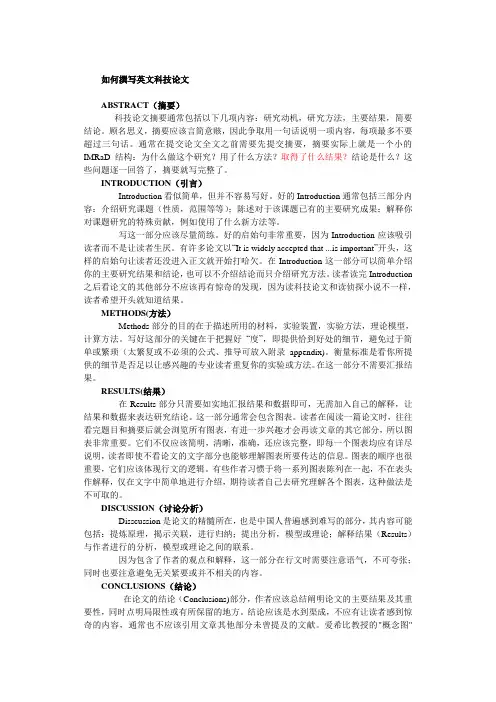
如何撰写英文科技论文ABSTRACT(摘要)科技论文摘要通常包括以下几项内容:研究动机,研究方法,主要结果,简要结论。
顾名思义,摘要应该言简意赅,因此争取用一句话说明一项内容,每项最多不要超过三句话。
通常在提交论文全文之前需要先提交摘要,摘要实际上就是一个小的IMRaD结构:为什么做这个研究?用了什么方法?取得了什么结果?结论是什么?这些问题逐一回答了,摘要就写完整了。
INTRODUCTION(引言)Introduction看似简单,但并不容易写好。
好的Introduction通常包括三部分内容:介绍研究课题(性质,范围等等);陈述对于该课题已有的主要研究成果;解释你对课题研究的特殊贡献,例如使用了什么新方法等。
写这一部分应该尽量简练。
好的启始句非常重要,因为Introduction应该吸引读者而不是让读者生厌。
有许多论文以“It is widely accepted that ...is important”开头,这样的启始句让读者还没进入正文就开始打哈欠。
在Introduction这一部分可以简单介绍你的主要研究结果和结论,也可以不介绍结论而只介绍研究方法。
读者读完Introduction 之后看论文的其他部分不应该再有惊奇的发现,因为读科技论文和读侦探小说不一样,读者希望开头就知道结果。
METHODS(方法)Methods部分的目的在于描述所用的材料,实验装置,实验方法,理论模型,计算方法。
写好这部分的关键在于把握好“度”,即提供恰到好处的细节,避免过于简单或繁琐(太繁复或不必须的公式、推导可放入附录appendix)。
衡量标准是看你所提供的细节是否足以让感兴趣的专业读者重复你的实验或方法。
在这一部分不需要汇报结果。
RESULTS(结果)在Results部分只需要如实地汇报结果和数据即可,无需加入自己的解释,让结果和数据来表达研究结论。
这一部分通常会包含图表。
读者在阅读一篇论文时,往往看完题目和摘要后就会浏览所有图表,有进一步兴趣才会再读文章的其它部分,所以图表非常重要。
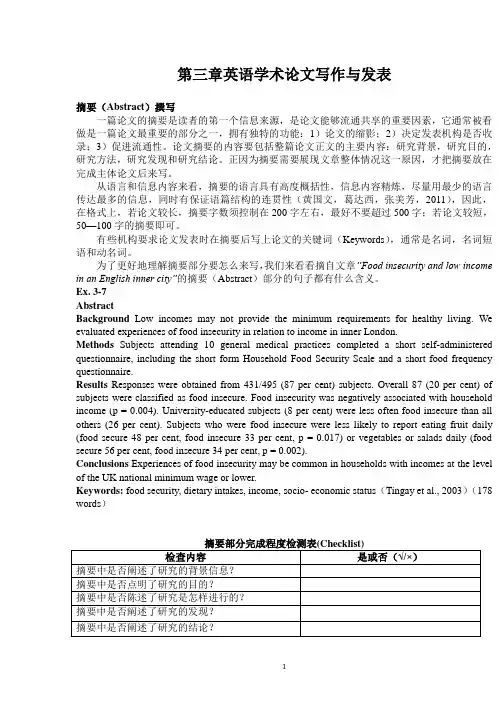
第三章英语学术论文写作与发表摘要(Abstract)撰写一篇论文的摘要是读者的第一个信息来源,是论文能够流通共享的重要因素,它通常被看做是一篇论文最重要的部分之一,拥有独特的功能:1)论文的缩影;2)决定发表机构是否收录;3)促进流通性。
论文摘要的内容要包括整篇论文正文的主要内容:研究背景,研究目的,研究方法,研究发现和研究结论。
正因为摘要需要展现文章整体情况这一原因,才把摘要放在完成主体论文后来写。
从语言和信息内容来看,摘要的语言具有高度概括性,信息内容精炼,尽量用最少的语言传达最多的信息,同时有保证语篇结构的连贯性(黄国文,葛达西,张美芳,2011),因此,在格式上,若论文较长,摘要字数须控制在200字左右,最好不要超过500字;若论文较短,50—100字的摘要即可。
有些机构要求论文发表时在摘要后写上论文的关键词(Keywords),通常是名词,名词短语和动名词。
为了更好地理解摘要部分要怎么来写,我们来看看摘自文章“Food insecurity and low income in an English inner city”的摘要(Abstract)部分的句子都有什么含义。
Ex. 3-7AbstractBackground Low incomes may not provide the minimum requirements for healthy living. We evaluated experiences of food insecurity in relation to income in inner London.Methods Subjects attending 10 general medical practices completed a short self-administered questionnaire, including the short form Household Food Security Scale and a short food frequency questionnaire.Results Responses were obtained from 431/495 (87 per cent) subjects. Overall 87 (20 per cent) of subjects were classified as food insecure. Food insecurity was negatively associated with household income (p = 0.004). University-educated subjects (8 per cent) were less often food insecure than all others (26 per cent). Subjects who were food insecure were less likely to report eating fruit daily (food secure 48 per cent, food insecure 33 per cent, p = 0.017) or vegetables or salads daily (food secure 56 per cent, food insecure 34 per cent, p = 0.002).Conclusions Experiences of food insecurity may be common in households with incomes at the level of the UK national minimum wage or lower.Keywords: food security, dietary intakes, income, socio- economic status(Tingay et al., 2003)(178 words)2.3.6论文修改修改论文时可以用以下评价标准(Assessment checklist)来从整体上检查论文是否达到要求。
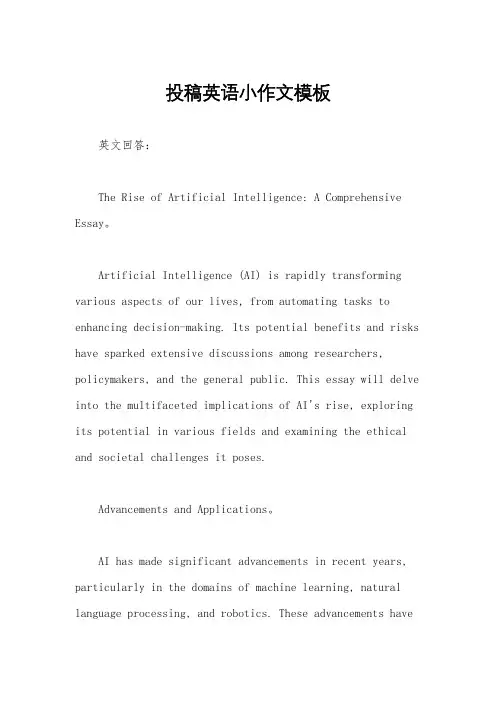
投稿英语小作文模板英文回答:The Rise of Artificial Intelligence: A Comprehensive Essay。
Artificial Intelligence (AI) is rapidly transforming various aspects of our lives, from automating tasks to enhancing decision-making. Its potential benefits and risks have sparked extensive discussions among researchers, policymakers, and the general public. This essay will delve into the multifaceted implications of AI's rise, exploring its potential in various fields and examining the ethical and societal challenges it poses.Advancements and Applications。
AI has made significant advancements in recent years, particularly in the domains of machine learning, natural language processing, and robotics. These advancements haveled to a wide range of applications, including:Automation: AI-powered systems can automate repetitive and time-consuming tasks, freeing up human workers to focus on more complex and creative endeavors.Enhanced Decision-Making: AI algorithms can analyze vast amounts of data and identify patterns and insightsthat may be missed by humans, aiding in decision-making processes.Medical Diagnosis and Treatment: AI systems are being used to diagnose diseases earlier, predict patient outcomes, and develop personalized treatment plans.Transportation: Self-driving cars and drones are revolutionizing transportation, promising increased efficiency, safety, and accessibility.Finance: AI is transforming the financial sector by automating trading operations, detecting fraud, andproviding personalized financial advice.Ethical and Societal Challenges。
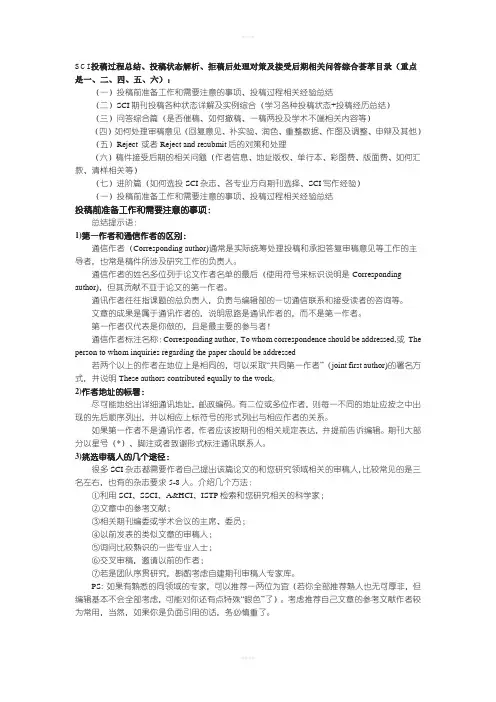
SCI投稿过程总结、投稿状态解析、拒稿后处理对策及接受后期相关问答综合荟萃目录(重点是一、二、四、五、六):(一)投稿前准备工作和需要注意的事项、投稿过程相关经验总结(二)SCI期刊投稿各种状态详解及实例综合(学习各种投稿状态+投稿经历总结)(三)问答综合篇(是否催稿、如何撤稿、一稿两投及学术不端相关内容等)(四)如何处理审稿意见(回复意见、补实验、润色、重整数据、作图及调整、申辩及其他)(五)Reject 或者Reject and resubmit后的对策和处理(六)稿件接受后期的相关问题(作者信息、地址版权、单行本、彩图费、版面费、如何汇款、清样相关等)(七)进阶篇(如何选投SCI杂志、各专业方向期刊选择、SCI写作经验)(一)投稿前准备工作和需要注意的事项、投稿过程相关经验总结投稿前准备工作和需要注意的事项:总结提示语:1)第一作者和通信作者的区别:通信作者(Corresponding author)通常是实际统筹处理投稿和承担答复审稿意见等工作的主导者,也常是稿件所涉及研究工作的负责人。
通信作者的姓名多位列于论文作者名单的最后(使用符号来标识说明是Corresponding author),但其贡献不亚于论文的第一作者。
通讯作者往往指课题的总负责人,负责与编辑部的一切通信联系和接受读者的咨询等。
文章的成果是属于通讯作者的,说明思路是通讯作者的,而不是第一作者。
第一作者仅代表是你做的,且是最主要的参与者!通信作者标注名称:Corresponding author,To whom correspondence should be addressed,或The person to whom inquiries regarding the paper should be addressed若两个以上的作者在地位上是相同的,可以采取“共同第一作者”(joint first author)的署名方式,并说明These authors contributed equally to the work。
英文科研论文投稿信Cover letter范本Dear [Journal Name/Editor],I am writing to submit my research article entitled "[Title of Your Research Article]" for consideration for publication in [Journal Name]. I believe that this article is a strong fit for your journal due to its relevance to the field and its potential contributions to existing literature.Background and SignificanceIn this study, we aimed to investigate [provide a brief background of the problem or topic], as it has not been extensively explored in previous research. The significance of this study lies in its potential to [explain why this research is important and how it can contribute to the advancement of knowledge in the field].Methodology and ResultsTo address our research objectives, we employed [describe the research methodology used] and collected data from [describe the sample or data collection process]. Our findings demonstrated [concisely summarize the main results and their implications]. These findings provide valuable insights into [explain how the results contribute to the existing body of knowledge and why they are important].Contribution to the FieldFit with [Journal Name]ConclusionYours sincerely,[Your Name][Your Affiliation][Your Contact Information]。
Distributed Diffusion-based Non-negative Least-Mean-SquareAlgorithm Over Adaptive NetworksXiaolong DengABSTRACTIn wireless sensor networks, distributed estimation over networks has received a lot of attention due to its broad applicability. We formulate and study distributed estimation algorithm based on diffusion protocols to implement cooperation among individual adaptive nodes. In the networks, every node is equipped with local leaning abilities, and they can share their local estimation and information with their neighbors. When the nodes communicate with each other, they keep to peer-to-peer protocols. And due to the inherent physical characteristics of systems under investigation, non-negativity is one of the most interesting constraints that can usually be imposed on the parameters to estimate. In distributed diffusion-based least-mean-square (LMS) algorithm, we add non-negative characteristics of parameters to the algorithm so that we can get a distributed diffusion-base non-negative least-mean-square algorithm over adaptive networks.Index Terms—Adaptive networks, diffusion algorithm, distributed estimation. least mean square algorithms, nonnegative constraints.INTRODUCTIONConsider a network of nodes observing temporal data arising from different spatial sources with possibly different statistical profiles. Each node in the network could function as an individual adaptive filter whose aim is to estimate the parameter of interest through local observations [1]–[3]. An adaptive network structure is obtained where the structure as a whole is able to respond in real-time to the temporal and spatial variations in the statistical profile of the data [4]–[6]. Different adaptation or learning rules at the nodes, allied with different cooperation protocols, give rise to adaptive networks of various complexities and potential. Our formulation is useful in several problems involving estimation and event detection from multiple nodes collecting space–time data [7]–[12].In many real-life phenomena including biological and physiological ones, due to the inherent physical characteristics of systems under investigation, non-negativity is a desired constraint that can be imposed on the parameters to estimate in order to avoid physically absurd and uninterpretable results. Over the last 15 years, a variety of methods have been developed to tackle nonnegative least-square problems (NNLS)[13]. Active set techniques for NNLS use the fact that if the set of variables which activate constraints is known, then the solution of the constrained least-square problem can be obtained by solving an unconstrained one that only includes inactive variables. The active set algorithm of Lawson and Hanson [14] is a batch resolution technique for NNLS problems. It has become a standard among the most frequently used methods. In [15], Bro and De Jong introduced a modification of the latter, called fast NNLS, which takes advantage of the special characteristics of iterative algorithms involving repeated use of non-negativity constraints. Another class of tools is the class of projected gradientalgorithms .They are based on successive projections on the feasible region. In [16], Lin used this kind of algorithms for NMF problems. Low memory requirements and simplicity make algorithms in this class attractive for large scale problems. Nevertheless, they are characterized by slow convergence rate if not combined with appropriate step size selection. Particularly efficient updates were derived in this way for a large number of problems involving non-negativity constraints .These algorithms however require batch processing, which is not suitable for online system identification problems.We propose and study a cooperation strategy that adopts a peer-to-peer diffusion protocol, in which nodes from the same neighborhood are allowed to communicate with each other at every iteration. At the same time, we add the non-negative characteristics to the parameters so that we can get a relatively accurate estimation, in addition, we can avoid physically absurd and uninterpretable results.REFERENCES[1] N. Kalouptsidis and S. Theodoridis, Adaptive System Identification and Signal Processing Algorithms. Englewood Cliffs, NJ: Prentice-Hall, 1993.[2] H. Sakai, J. M. Yang, and T. Oka,“ Exact convergence analysis of adaptivefilter algorithms without the persistently exciting condition,”IEEE Trans. Signal Process., vol. 55, no. 5, pp. 2077–2083, May 2007.[3] A. H. Sayed, Fundamentals of Adaptive Filtering. New York: Wiley,2003.[4] C. G. Lopes and A. H. Sayed, “Incremental adaptive strategies over distributed networks,”IEEE Trans, Signal Process., vol. 55, no. 8, pp.4064–4077, Aug. 2007.[5] A. H. Sayed and C. G. Lopes,“ Adaptive processing over distributed networks,” IEICE Trans. Fund. Electron. Commun. Comput. Sci., vol.E90-A, no. 8, pp. 1504–1510, 2007.[6] F. S. Cattivelli, C. G. Lopes, and A. H. Sayed, “Diffusion recursive least-squares for distributed estimation over adaptive networks,”IEEE Trans. Signal Process., vol. 56, no. 5, pp. 1865–1877, May 2008.[7] D. Estrin, G. Pottie, and M. Srivastava, “Instrumenting the world with wireless sensor networks,” inProc. Int. Conf. Acoustics, Speech, Signal Processing (ICASSP), Salt Lake City, UT, May 2001, pp. 2033–2036.[8] L. A. Rossi, B. Krishnamachari, and C.-C. J. Kuo, “Distributed parameter estimation for monitoring diffusion phenomena using physical models,”inProc. 1st IEEE Conf. Sensor Ad Hoc Communications Networks, Santa Clara, CA, Oct. 2004, pp. 460–469.[9] D. Li, K. D. Wong, Y. H. Hu, and A. M. Sayeed,“ Detection, classification, and tracking of targets,”IEEE Signal Process. Mag., vol. 19, no. 2, pp. 17–29, Mar. 2002.[10] C. G. Lopes and A. H. Sayed,“Diffusion least-mean squares over adaptive networks,”inProc. Int. Conf. Acoustics, Speech, Signal Processing (ICASSP), Honolulu, HI, Apr. 2007, vol. 3, pp. 917–920.[11] A. H. Sayed and C. G. Lopes, “Distributed recursive least-squares strategies over adaptive networks,”in P roc. 40th Asilomar Conf. Signals, Systems, Computers, Pacific Grove, CA, Oct. 2006, pp. 233–237.[12] Cassio G. Lopes, Student Member,”Diffusion Least-Mean Squares Over Adaptive Networks: Formulation and Performance Analysis,” IEEE Transactions On Signal Processing.,vol.56,No.7,July 2008 , pp.3122-3136.[13] Jie Chen, Cédric Richard, Senior Member,” Nonnegative Least-Mean-Square Algorithm.”IEEE Transactions On Signal Processing.,vol.59, no.11,November 2008 , pp.5225-5235.[14] wsonandR.J.Hanson, Solving Least Squares Problems. Philadelphia, PA: Society for Indust. and Appl. Math., 1995.[15] R. Bro and S. De Jong, “A fast non-negativity-constrained least squares algorithm,”J. Chemometr., vol. 11, no. 5, pp. 393–401, 1997.[16] C. J. Lin, “Projected gradient methods for nonnegative matrix factorization,”Neural Computat., vol. 19, no. 10, pp. 2756–2779, 2007.。